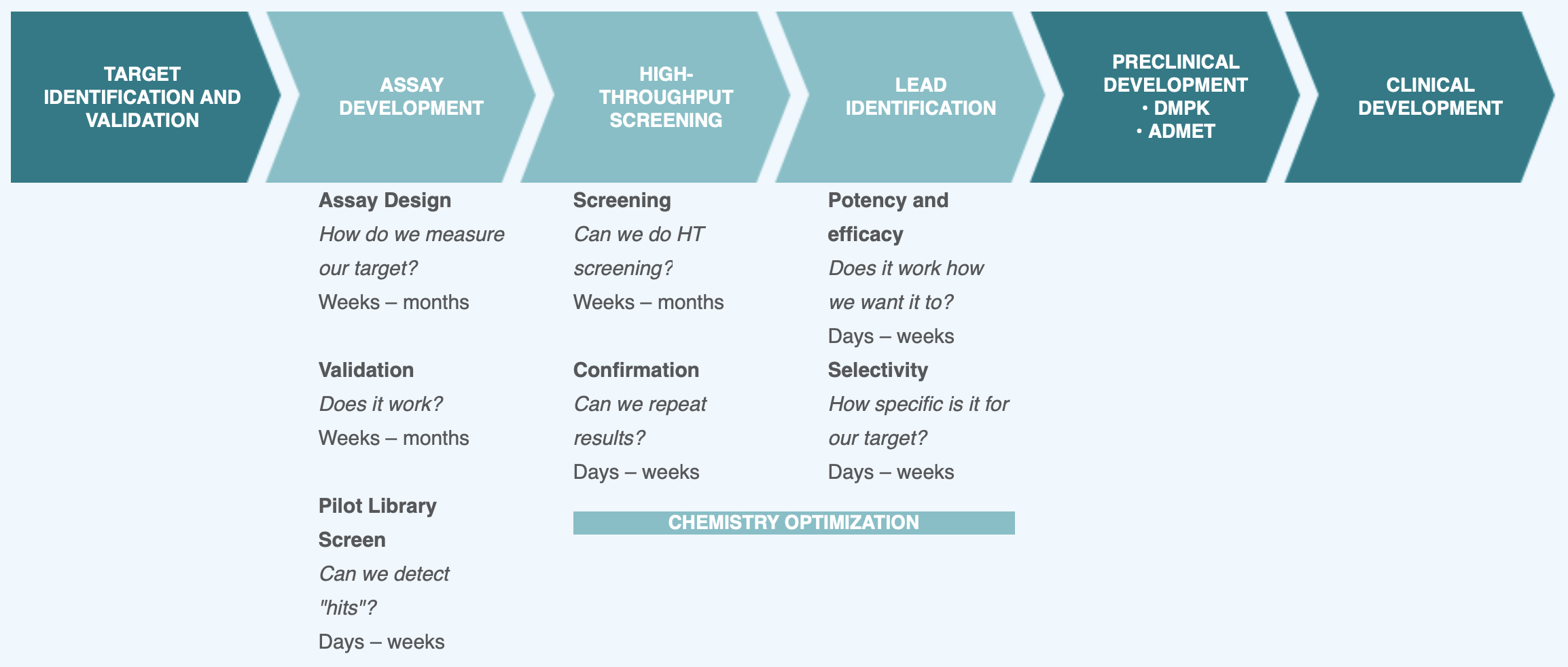Services
The Vanderbilt HTS Facility provides various services to the research community. Consultations are available for assay design, optimization, development, and validation, as well as for integrating automated HTS and data analysis.
The compound collection can be accessed independently of screening, and HTS-compatible supplies for testing and validation are available. Training services are also provided to allow for walk-up use of state-of-the-art instruments. To contact HTS staff to discuss specific needs, please log in with your institution’s iLab account and complete the Project Request Form. Staff will evaluate requests and provide information describing the suggested resources required.
Train independent users Screen compounds Compound distribution
ASSAY DESIGN AND VALIDATION
Through the advanced, HTS-compatible instruments, the HTS facility supports a wide variety of detection modalities for assay measurements, including absorbance, fluorescence, time-resolved fluorescence, fluorescence polarization, fluorescence resonance energy transfer (FRET), time-resolved FRET, luminescence, bioluminescence resonance energy transfer (BRET) and scintillation proximity assays (SPA). Cell-based and cell-free assays in experimental systems that have been used in prior models have included but are not limited to recombinant proteins, membrane fractions, cellular isolates, cell lysates, cell lines, and whole model organisms (e.g., zebrafish, C. elegans, and yeast).
The HTS facility is proficient at helping research investigators develop HTS-compatible assays, obtain preliminary data for grants and funding opportunities, and to screen for the identification and investigation of new compounds for basic research and pharmacological discovery. Discoveries include novel modulators of G-protein coupled receptors, ion channels, transporters, proteases, oxidoreductases, cellular adhesion proteins, lipases, growth factor receptors, proto-oncogenes, protein-protein interactions, DNA-protein interactions, and other molecular targets and pathways that are important in numerous diseases such as neurodegenerative diseases, cardiovascular diseases, malaria, bacterial and viral diseases/illnesses, diabetes, cancer, and HIV.
Assay Targets:
- GPCR Modulators
- Ion Channel Modulators
- Cardiovascular Zebrafish Models
- Diabetes Targets
- Anti-Malarial Targets
- Foodborne Illness Targets
- Coagulation Inhibitors
- Transcriptional Modulators
- COX Inhibitors
- Choline Transporters
- Obesity and Cachexia Regulation Target
- Colon Cancer Targets
- Pancreatic Cancer Targets
- Lung Cancer Targets
- Breast Cancer Targets
A project begins with a Project Request Form in iLab. Once received, an HTS staff will schedule a consultation to discuss the adaptation and implementation of the assay to the HTS facility. Typically, assays are validated manually by individual laboratories and evaluated to determine the level of automation and instrumentation needed for HTS services. Once the assay is validated with positive and negative controls and the robustness of the assay (Z-factor/Z’) is determined the assay is ready to be automated. During validation of the automation, manual steps are replaced systematically with instruments to ensure accuracy and precision/fidelity of the assay as observed in the manual process. For example, manual pipetting into a 384-well plate can be replaced with the use of a Thermo Multidrop, which dispenses liquid into an entire plate evenly and accurately in seconds. Another example is the Velocity11 Bravo liquid handler; this device can aspirate liquid from an entire plate, wash it, and add a solution to a plate precisely in a few minutes. After determining the sequence of events and instrumentation for the assay, a robotic sequence called a schedule is created to integrate these assay procedures into an automated fashion.
The software determines the amount of time each sample will take during individual movements of the robot and the composite time for all samples to be assayed. Testing of the schedule begins with running the schedules for individual instruments, followed by testing of all instruments without reagents, and finally, testing of all instruments with water. Next, an experiment is run using all instruments and robotics integrated by the schedule with experimental controls. The assay is ready for compound screening after the biological procedure and the instrumentation are validated. The growing library available for screening includes over 160,000 compounds.
HTS can generate a large number of data, and our specialized HTS informatics staff can assist with custom-made software to help assimilate, analyze, and reduce data to appropriate specifications for hit picking, follow-up analyses, and hit validation.
COMPOUND SCREENING

TRAINING AND WALK-UP INSTRUMENT USE
Most of the HTS instruments are available for walk-up use. Instruments can be reserved online for as little as 15 minutes at a time, and instruments can be accessed 24 hours a day, seven days a week. A short training for every HTS instrument and automation is required for use and for reserving instrument time. Training includes understanding the capabilities of the instrument, the limitations, instrument functions and safety, data capture, analysis, access, and storage, as well as HTS facility policies and procedures for instrument access and use. Training time will be charged to the investigator’s account and generally lasts between 30-60 minutes, depending on the equipment being used. Following training access to the HTS facility and instrument reservation and usage will be granted. Our instruments can be found here.
GRANT WRITING INFORMATION
The HTS staff can help research investigators with HTS related grant writing and funding opportunities. The HTS staff will be happy to provide budget quotes, facility descriptions, and letters of recommendation and support. All new users need to complete the Intake Form for assistance with grants. If you are a current user or have questions, please email the Vanderbilt HTS Core.
USABLE GRANT TEXT
Please contact HTS Staff for grant content to meet your specific needs: HTS@vanderbilt.edu
FUNDING INFORMATION
Listed below are several resources with information for funding HTS projects.
- VICTR Grants
- Vanderbilt University Funding Programs
- PAR-17-438 (NCI, NIAID, NIDCD, NIDA, NIMH) Assay development and screening for discovery of chemical probes or therapeutic agents (R01)
- Innovation Grants to Nurture Initial Translational Efforts (IGNITE): Assay Development and Therapeutic Agent Identification
- PAR-16-374 Assay Development and Screening to Discover Therapeutic or Imaging Agents for Diseases of Interest to the NIDDK (R01)
- NCI Experimental Therapeutics Program (NExT)
- ADDC Partnerships listed through the Academic Drug Discovery Cons